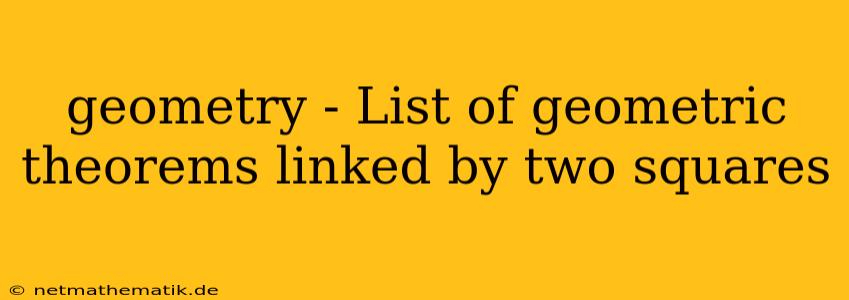Exploring Geometric Connections: Theorems Linked by Two Squares
The realm of geometry abounds with elegant theorems, each a testament to the intricate relationships between shapes, lines, and angles. Among these, a particularly fascinating subset explores the interplay between two squares. These theorems, while seemingly simple in their premise, reveal profound connections within the geometric world. This article delves into a selection of such theorems, highlighting their unique properties and showcasing the interconnected nature of geometry.
Pythagorean Theorem: The Foundation of Right Triangles
The most fundamental theorem linking two squares is the Pythagorean Theorem, a cornerstone of geometry. This theorem states that in a right triangle, the square of the hypotenuse (the side opposite the right angle) is equal to the sum of the squares of the other two sides.
Figure 1: Pythagorean Theorem
!
The theorem can be represented algebraically as:
a² + b² = c²
where 'a' and 'b' are the lengths of the two shorter sides (legs) and 'c' is the length of the hypotenuse.
The Pythagorean Theorem allows us to calculate the length of any side of a right triangle if we know the lengths of the other two sides. This theorem finds applications in numerous fields, from engineering and architecture to navigation and trigonometry.
The Square of the Diagonal of a Square
Another notable theorem connects the diagonal of a square with its side length. This theorem states that the square of the diagonal of a square is equal to twice the square of its side.
Figure 2: Diagonal of a Square
!
If we denote the side length of the square as 's' and the diagonal as 'd', the theorem can be represented as:
d² = 2s²
This theorem can be proven using the Pythagorean Theorem. The diagonal of a square divides it into two congruent right triangles. Applying the Pythagorean Theorem to one of these triangles, we get:
s² + s² = d²
Therefore, d² = 2s².
The Area of a Square: A Simple Relationship
The area of a square is simply the product of its side length. However, this simple relationship can be linked to the diagonal of the square.
Figure 3: Area of a Square
!
The area of a square with side length 's' is s². Using the relationship between the diagonal and the side length (d² = 2s²), we can express the area in terms of the diagonal:
s² = d²/2
Therefore, the area of the square is equal to half the square of its diagonal.
The Theorem of Pythagoras and Two Squares: A Visual Proof
The Pythagorean Theorem can be visualized using two squares. Consider two squares, one with sides of length 'a' and the other with sides of length 'b'.
Figure 4: Visual Proof of Pythagorean Theorem
!
We can arrange these squares so that they share a common vertex. A third square can be constructed with sides of length 'c', where 'c' is the hypotenuse of a right triangle with sides 'a' and 'b'. This square will have an area equal to c².
The area of the square with side 'c' is equal to the sum of the areas of the two smaller squares. This can be expressed as:
a² + b² = c²
This visually demonstrates the Pythagorean Theorem and emphasizes the link between two squares.
Conclusion
The interplay between two squares is a rich source of geometric theorems, revealing interconnectedness within the field. From the fundamental Pythagorean Theorem to the relationship between a square's diagonal and its side length, these theorems provide valuable insights into geometric principles.
